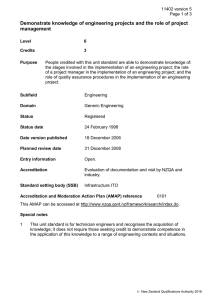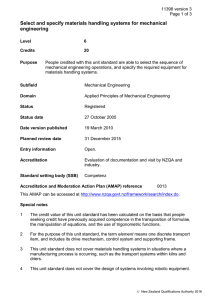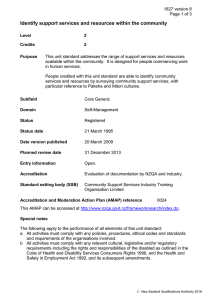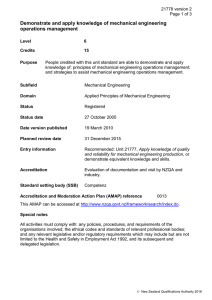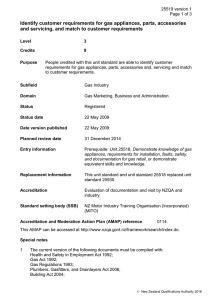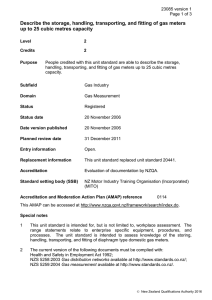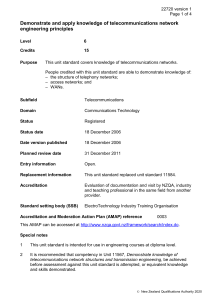Demonstrate knowledge of engineering contract law and documentation
advertisement
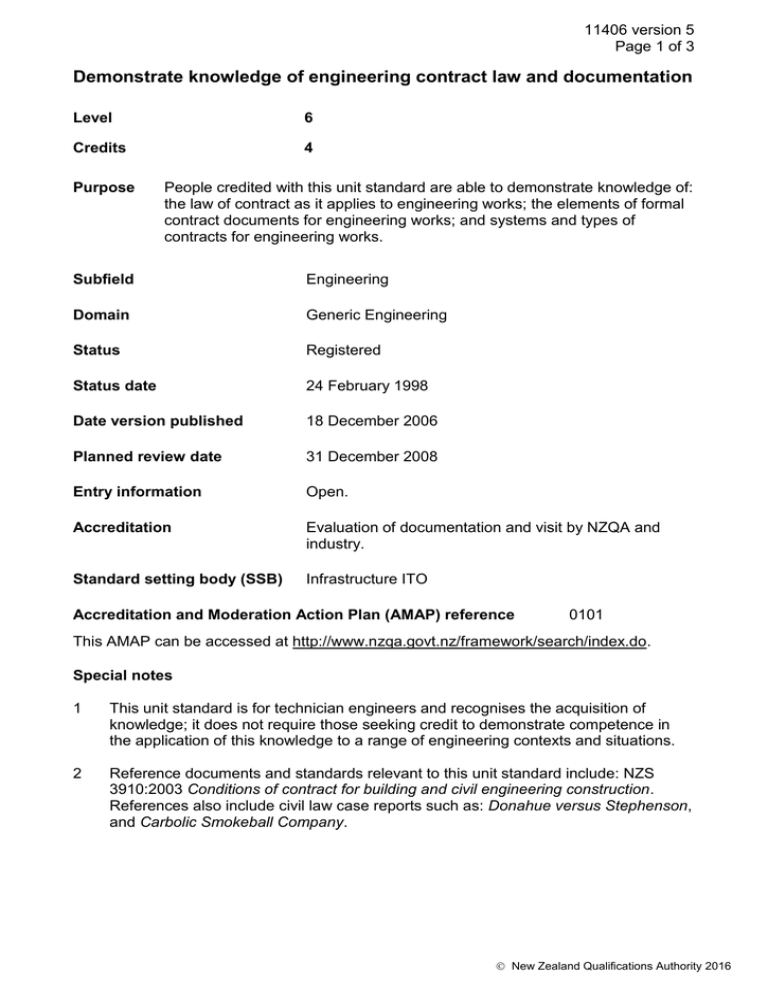
11406 version 5 Page 1 of 3 Demonstrate knowledge of engineering contract law and documentation Level 6 Credits 4 Purpose People credited with this unit standard are able to demonstrate knowledge of: the law of contract as it applies to engineering works; the elements of formal contract documents for engineering works; and systems and types of contracts for engineering works. Subfield Engineering Domain Generic Engineering Status Registered Status date 24 February 1998 Date version published 18 December 2006 Planned review date 31 December 2008 Entry information Open. Accreditation Evaluation of documentation and visit by NZQA and industry. Standard setting body (SSB) Infrastructure ITO Accreditation and Moderation Action Plan (AMAP) reference 0101 This AMAP can be accessed at http://www.nzqa.govt.nz/framework/search/index.do. Special notes 1 This unit standard is for technician engineers and recognises the acquisition of knowledge; it does not require those seeking credit to demonstrate competence in the application of this knowledge to a range of engineering contexts and situations. 2 Reference documents and standards relevant to this unit standard include: NZS 3910:2003 Conditions of contract for building and civil engineering construction. References also include civil law case reports such as: Donahue versus Stephenson, and Carbolic Smokeball Company. New Zealand Qualifications Authority 2016 11406 version 5 Page 2 of 3 3 The following note shall apply to the performance of all elements in this unit standard: all activities must comply with any policies, procedures, and requirements of the organisations involved; the ethical codes and standards relevant to professional bodies; and any relevant cultural, legislative and/or regulatory requirements, which may include but are not limited to: the Treaty of Waitangi, Health and Safety in Employment Act 1992, Resource Management Act 1991, Building Act 2004, Copyright Act 1994, Contracts Enforcement Act 1956, Contracts (Privity) Act 1982, and their subsequent amendments and regulations. Elements and performance criteria Element 1 Demonstrate knowledge of the law of contract as it applies to engineering works. Performance criteria 1.1 The description establishes the essential components required to form a legally binding contract. Range offer, acceptance, reward, performance, legal capabilities of parties, specific agreements, legal objectives and outcomes. Element 2 Demonstrate knowledge of the elements of formal contract documents for engineering works. Performance criteria 2.1 The description outlines elements of general conditions of contract as identified in the table of contents for NZS 3910:2003. 2.2 The description outlines the documents that are essential elements of a formal contract for engineering works. Range documents include those relating to – conditions of tendering, the tender, the letter of acceptance, general conditions of contract, special conditions of contract, specifications, drawings, schedule of prices. Element 3 Demonstrate knowledge of systems and types of contracts for engineering works. Performance criteria 3.1 The description outlines systems of contracts at they relate to engineering works. Range fixed-price, cost-reimbursable, design-and-build. New Zealand Qualifications Authority 2016 11406 version 5 Page 3 of 3 3.2 The description outlines types of contracts as they relate to engineering works. Range lump-sum, schedule of quantities, schedule of rates, cost-plus percentage, cost-plus-fixed fee, cost-plus fluctuating fee. Please note Providers must be accredited by the Qualifications Authority, or an inter-institutional body with delegated authority for quality assurance, before they can report credits from assessment against unit standards or deliver courses of study leading to that assessment. Industry Training Organisations must be accredited by the Qualifications Authority before they can register credits from assessment against unit standards. Accredited providers and Industry Training Organisations assessing against unit standards must engage with the moderation system that applies to those standards. Accreditation requirements and an outline of the moderation system that applies to this standard are outlined in the Accreditation and Moderation Action Plan (AMAP). The AMAP also includes useful information about special requirements for organisations wishing to develop education and training programmes, such as minimum qualifications for tutors and assessors, and special resource requirements. Comments on this unit standard Please contact Infrastructure ITO askus@infratrain.co.nz if you wish to suggest changes to the content of this unit standard. New Zealand Qualifications Authority 2016


